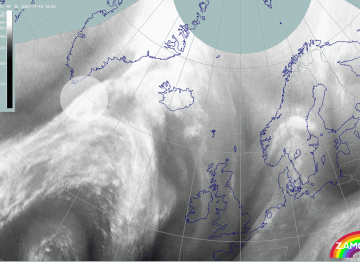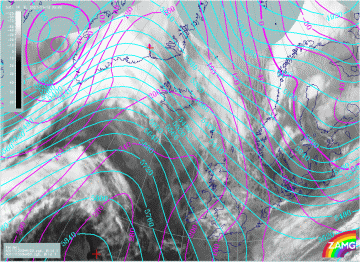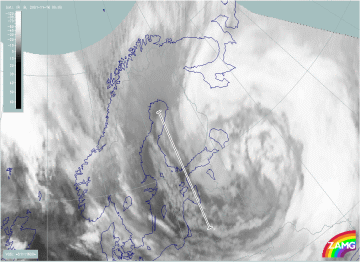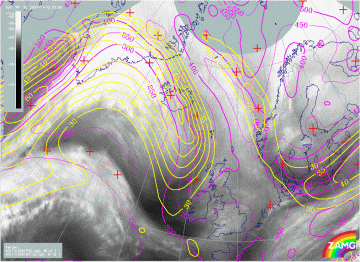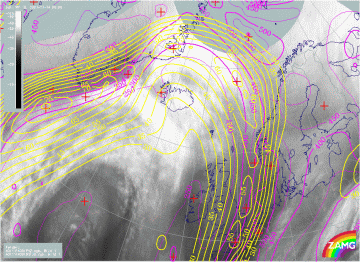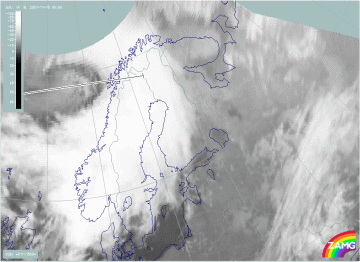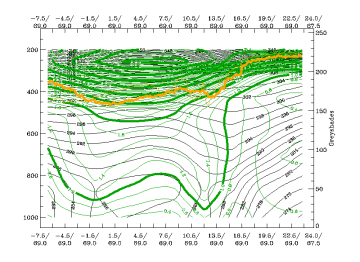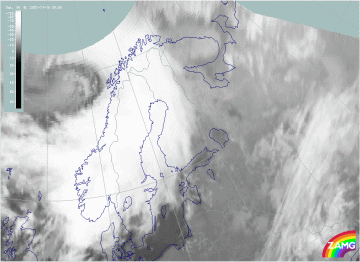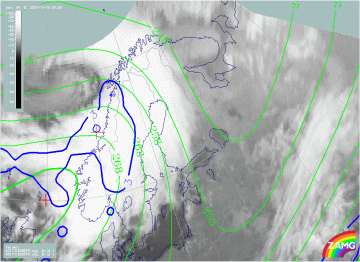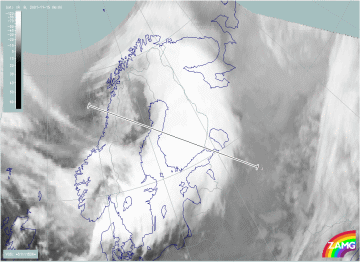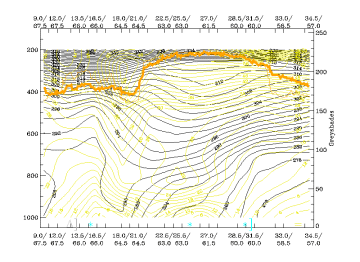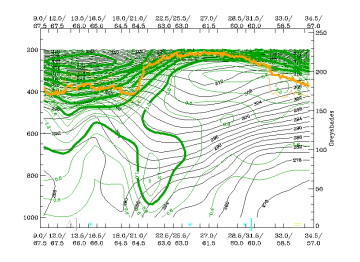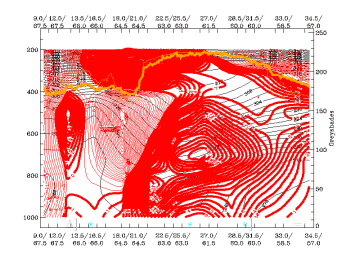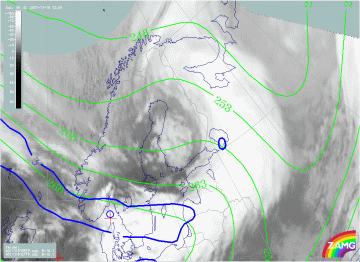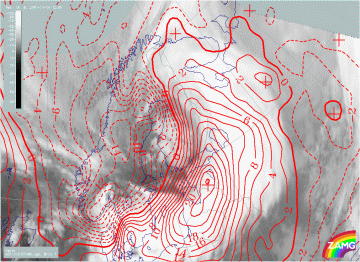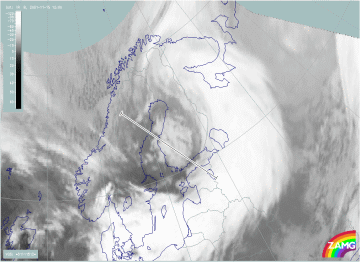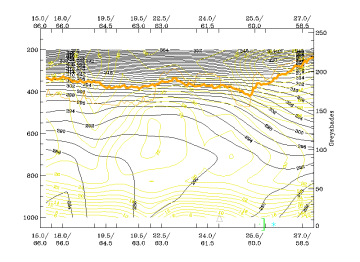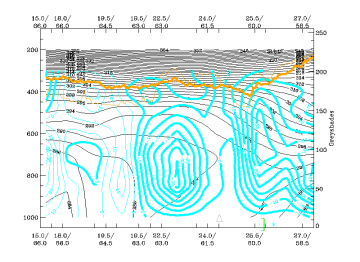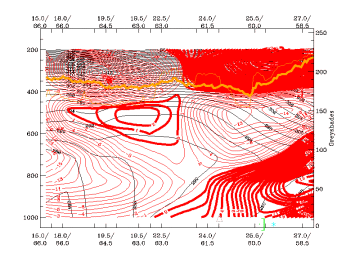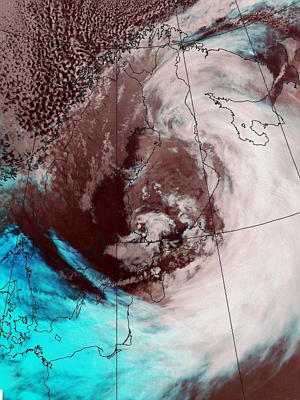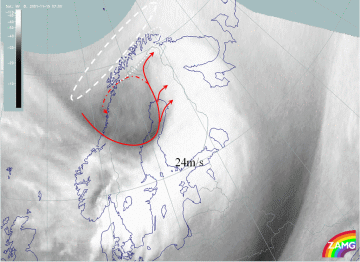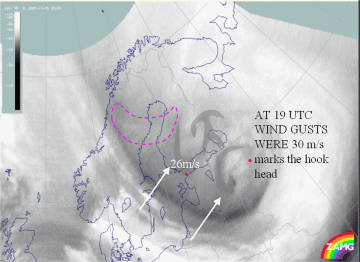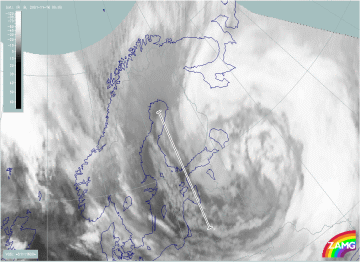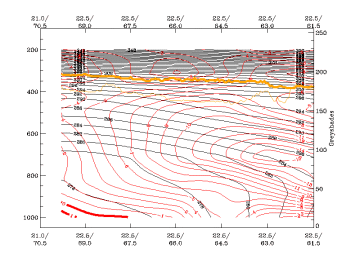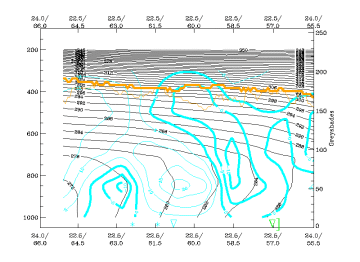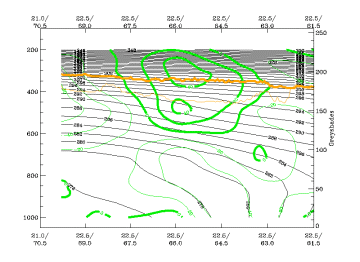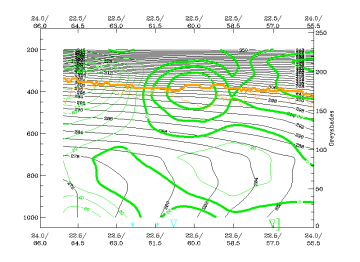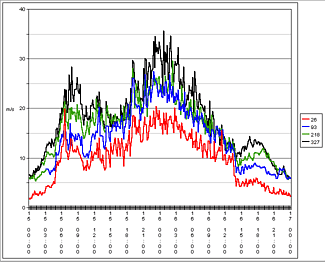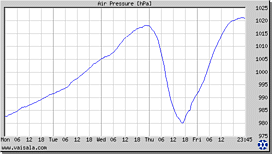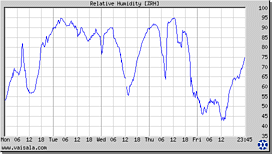Table of Contents
Introduction
From 10th to 16th of November 2001 a series of intensive storms moved over the Northern Atlantic and passed through Scandinavia and Finland to the east. A few of the storms were remnants of hurricanes but the one storm that caused extensive damage, at least to Finland, was of a smaller scale. It was named "Janika". The naming "Janika" is not according to international conventions but was introduced by the Finnish Meteorological Institute (FMI). For convenience it is used in this manual for storm identification.
From a satellite meteorology point of view, the storm Janika is an ideal example of Greenland lee cyclogenesis which is a local type of Rapid Cyclogenesis: An old Occlusion was located over the middle and northern parts of Greenland. A Wave (denoted in the loop below with a white circle) travelled from the south of Greenland, from the right side of the jet axis to the left side, and towards the Occlusion point.
|
13 November 2001/15.00 UTC - Meteosat WV image; yellow: isotachs 300 hPa, magenta: height of PV = 2 units; 13/00.00 - 13/21.00 UTC
3-hourly image loop
|
|
A Dark Stripe, seen in the WV images, grew remarkably to the lee of Greenland. Jet Intensification took place and Rapid Cyclogenesis started. In the next loop a minor low forms near the eastern tip of Greenland. At the same time the upper level flow becomes more westerly and at the surface a sharp ridge of high pressure forms over Greenland.
|
13 November 2001/00.00 UTC - Meteosat IR image; cyan: height contours 500 hPa, magenta: height contours 1000 hPa; 13/00.00 - 15/00.00
UTC 3-hourly image loop
|
|
Janika is also a good case for investigating developments that can cause extremely gusty winds. In Janika the turbulent flows were connected to two broad low level jets, one in the warm advection, the other in the cold pool associated with the Arctic Cold Front. A third phenomenon, a deep tropospheric gravity wave, had an additional impact on wind gusts. Some of the processes started in the Water Vapor Eye region and are related to vorticity fluctuations and the generation of gravity waves. These concepts will be discussed in more detail in the next chapters.
From a forecaster's point of view, the storm will be well remembered, since the associated rise and fall of pressure as the low passed over Finland was large, nearly 16 hPa/3 hours, and very strong wind gusts appeared as organised weather sequences. These are explained by analysing Doppler radar images. Winds became stronger than predicted although forecasts had already indicated the possibility of a severe storm. The destruction caused by Janika was extensive due to the strong wind gusts, many resembling downbursts or F2 scale tornadoes. As a result of storm Janika, FMI and various authorities began to develop better ways for issuing warnings of severe weather events.
This catastophic weather situation addresses Rapid Cyclogenesis, Dark Stripes and Occlusions (see Rapid Cyclogenesis , Dark Stripes and Occlusion: Warm conveyor Belt Type ). The impact of Greenland on Rapid Cyclogenesis, a theory related to gravity waves, and the creation of white arc lines in water vapor images are also presented in this case.
Overview of gravity waves
Rapid Cyclogenesis on the leeside of Greenland
Rapid Cyclogenesis to the lee of Greenland is possible if stable stratified air is forced to rise over the Greenland shelf. Large amplitude gravity waves may form and their propagation upwards amplify, in part due to the decrease in atmospheric density. The upward wave propagation can subsequently result in overturning waves and turbulent breakdown. This can then result in deeper lower-troposheric adiabatic cooling.
When this happens, the cold pool can grow as large as 500-1000 km in diameter in the layer 2-6 km above the surface. This kind of event took place over the Northern Atlantic when Janika was deepening. It can be seen in the loop below seen in the spreading of cold advection at 700 hPa. According to several theories the expansion of the cold pool can lead to the formation of a very strong jet stream.
|
13 November 2001/18.00 UTC - Meteosat IR image; red: temperature advection 700 hPa; 13/18.00 - 15/00.00 UTC 6-hourly image loop
|
|
Gravity waves and their appearance
Common to all gravity waves is the fact that they occur in regions where weak mid-tropospheric static stability overlays a strong stable layer. Rapid amplification of waves typically occurs as they enter a region of highly stable cold air.
Behind the southern and eastern edges of the gust front related to a gravity wave, a compact region of latent heating near the tropopause is often enclosed. A similar feature was observed in Finland associated with the passage of Janika. In the vertical cross sections on 16 November 2001 at 00.00 UTC a local maximum in WA appears and could be a sign of such a feature.
|
16 November 2001/00.00 UTC - Meteosat IR image; position of vertical cross section indicated
|
16 November 2001/00.00 UTC - Vertical cross section; black: isentropes (ThetaE), red: temperature advection, orange thin: IR pixel
values, orange thick: WV pixel values
|
Gravity waves can be amplified just downstream of high velocity jet cores in a region of strongly increasing divergence. A so called deep tropospheric gravity wave often occurs when:
- A polar Cold Front moves from the ocean over the land or
- A southward surge of arctic air takes place down the eastern side of a mountain range.
In Janika's case both of these factors were present.
In water vapour imagery the waves can been seen as rapidly propagating, narrow 10-30 km and 500-1000 km long white arc lines. The absence of significant cloudiness makes them detectable primarily in the water vapour images.
Main features
Tropopause fold and Water Vapor Eye
A major tropopause fold developed to the lee side of Greenland in a rapidly strengthening upper level flow. When the jet stream swept over southern Greenland on 13 November 2001 at 00.00 UTC, jet maxima were near 60 m/s and a long Dark Stripe, seen in the WV imagery, reached from the jet axis to the left exit region. This can be seen in the loop below.
|
13 November 2001/00.00 UTC - Meteosat WV image; yellow: isotachs 300 hPa, magenta: height of PV = 2 units; 13/00.00 - 13/18.00 UTC 6-hourly image loop
|
|
In the next twelve hours the Dark Stripe on the eastern side of the southern tip of Greenland darkened further, and it acquired the appearance of a Water Vapour Eye. The associated PV fields show this development very clearly; a distinct PV anomaly is located just within the dark Water Vapour Eye.
The jet stream became stronger by some 15 m/s, according to the model fields. The Occlusion over the central parts of Greenland moved eastwards over the sea. A long and strong westerly jet existed between southern Greenland and Norwegian Sea. Its maximum speed was over 80 m/s. Because the jet curved anticyclonically over Finland towards the southwest it allowed the storm to arrive in Finland with all its power.
|
14 November 2001/00.00 UTC - Meteosat WV image; yellow: isotachs 300 hPa, magenta: height of PV = 2 units; 14/00.00 - 15/00.00 UTC 6-hourly image loop
|
|
The tropopause fold stretched down into the lower troposphere as the surface low deepened. The structure of the major folding is seen in more detail in vertical cross sections. Behind the major tropopause fold existed a second fold which was associated with an Occlusion more to the south. In Janika's case it was not that relevant.
|
15 November 2001/00.00 UTC - Meteosat IR image; position of vertical cross section indicated
|
15 November 2001/00.00 UTC - Vertical cross section; black: isentropes (ThetaE), green: potential vorticity, orange thin: IR pixel
values, orange thick: WV pixel values
|
As the tropopause folding became deeper the Water Vapour Eye grew larger in the left exit region of the jet. This, in turn, intensified the existing fronts and sustained the deepening of the cyclone.
As the Water Vapour Eye grew in size, it turned more oval in appearance. During this stage, small scale cloud features began to develop within the Water Vapour Eye. The Water Vapour Eye was situated within an area enclosed by a Kata Cold Front, a Warm Conveyor Belt Type Occlusion and an Arctic Cold Front. The frontal structures cannot be seen very clearly in TFP image; only the Warm Front over the Scandinavian mountains and the Cold Front over the Norwegian Sea are clearly seen, while the TFP is below threshold value for the Occlusion spiral over the Arctic Sea.
|
14 November 2001/00.00 UTC - Meteosat IR image; 14/00.00 - 15/00.00 UTC 3-hourly image loop
|
14 November 2001/00.00 UTC - Meteosat WV image; 15/00.00 - 15/06.00 UTC hourly image loop
|
|
|
|
|
15 November 2001/00.00 UTC - Meteosat IR image; blue: thermal front parameter (TFP), green: thickness 500/850 hPa
|
|
Occluded front and low level winds over Finland
The following images show a cross section through the cloud system during the period when the occluded front had already reached Finland. Isotaches show very clearly the low-level jet which can be seen at 850 hPa, maximum wind speed being 28 m/s. Similar speeds for southerly or southwesterly wind gusts over the sea were observed in southern Finland, which was located within the warm sector at that time.
The tropopause fold can also be seen very clearly, PV>1 values extending down to around 900 hPa. The location of this anomaly coincides with the Occlusion point.
The extremely intensive temperature advection is seen in the respective (lower right) cross section. Warm advection extends throughout the troposphere, with its maximum being at 700 hPa; the cold advection at the rear of the Occlusion front is also very pronounced.
|
15 November 2001/06.00 UTC - Meteosat IR image; position of vertical cross section indicated
|
15 November 2001/06.00 UTC - Vertical cross section; black: isentropes (ThetaE), yellow: isotachs, orange thin: IR pixel values, orange
thick: WV pixel values
|
|
15 November 2001/06.00 UTC - Vertical cross section; black: isentropes (ThetaE), green: potential vorticity, orange thin: IR pixel
values, orange thick: WV pixel values
|
15 November 2001/06.00 UTC - Vertical cross section; black: isentropes (ThetaE), red: temperature advection, orange thin: IR pixel
values, orange thick: WV pixel values
|
The occluding process continued as the Cold Front passed southeastwards over the southern parts of Finland. Wind speeds decreased a little and many people thought that the storm was over. Behind the Occlusion were several troughs, resulting in local heavy showers of sleet and snow. The area of troughs originated in Greenland. Due to the impact of Greenland (as described previously in overview chapter) these troughs may have acquired a more intensive character.
The following images show the location of the occlusion at 12.00 UTC on 15 November 2001. The frontal cloudiness is now moving away from Finland; TFP is, surprisingly, very low but warm and cold advection are still extreme.
|
15 November 2001/12.00 UTC - Meteosat IR image; blue: thermal front parameter (TFP), green: thickness 500/850 hPa
|
15 November 2001/12.00 UTC - Meteosat IR image; red: temperature advection 850 hPa
|
Cloud features behind the Occlusion
The following image loop shows the passage of the system southeastwards over Finland. Behind the main Occlusion cloud spiral, convective clouds develop and a couple of them acquire a Comma cloud appearance as they move across Finland.
|
15 November 2001/07.00 UTC - Meteosat IR image; 15/07.00 - 15/14.00 UTC hourly image loop
|
|
The following cross sections show the vertical motion and temperature advection associated with the Comma clouds. The upward motion seems to be strongest at 800 hPa. Warm advection dominates in the upper troposphere between 600 and 400 hPa level where the winds were weakest.
|
16 November 2001/06.00 UTC - Meteosat IR image; position of vertical cross section indicated
|
16 November 2001/06.00 UTC - Vertical cross section; black: isentropes (ThetaE), yellow: isotachs, orange thin: IR pixel values, orange
thick: WV pixel values
|
|
16 November 2001/06.00 UTC - Vertical cross section; black: isentropes (ThetaE), cyan thick: vertical motion (omega) - upward motion,
cyan thin: vertical motion (omega) - downward motion, orange thin: IR pixel values, orange thick: WV pixel values
|
16 November 2001/06.00 UTC - Vertical cross section; black: isentropes (ThetaE), red: temperature advection, orange thin: IR pixel
values, orange thick: WV pixel values
|
What was unusual was the 200 km long and 30 km wide arc cloud that formed in northern parts of Finland. Its lifetime was short and it was only seen in the NOAA images. In the following image the arc cloud can be seen over the Finnish coast side of the Bay of Bothnia, around 63 N 22 E.
|
15 November 2001/13.53 UTC - NOAA image
|
|
Behind the arc cloud there existed a strongly turbulent area, where the wind shear in the boundary layer was large, cold advection increased upwards, and downward motion dominated. This turbulent area was to some extent connected to the Dark Stripes (WV image).
Dark Stripes
Dark Stripes (seen in the WV images) formed around the Water Vapour Vortex which, by 15 November 00.00 UTC, reached the Scandinavian mountains and moved further southeast. As the vortex reached the northern Scandinavian mountains it already began to stretch and deform into several diverging Dark Stripes. The diverging Dark Stripes behaved differently over Finland as is seen in the following loops.
|
15 November 2001/07.00 UTC - Meteosat WV image; 15/07.00 - 15/14.00 UTC hourly image loop
|
|
The branch of stripes that turned clockwise became a group of smaller dark or grey hooks. This group did not cause such strong wind gusts as those hooks that turned anticlockwise.
A hook that formed from the tail of the longest clockwise turning branch moved separately southwards. Strong wind gusts were associated with this dark hook: over the sea above 32 m/s, and over the land between 22-28 m/s. The wind gusts observed were strongest in the southern head of the hook. For instance, as the hook head was over Tampere (62N/25E) at 18.00 UTC, wind gusts rose from 18 m/s up to 28 m/s. Two hours later the hook head was over Helsinki (60N/25E), and wind gusts there increased by some 10 m/s, reaching 26 m/s.
|
15 November 2001/20.00 UTC - Meteosat WV image
|
|
White arc line and the gravity wave
During the late evening and night a curved white area approached Finland from the Barents Sea. At 21.00 UTC the white area had shrunk into a narrow white arc line. To the lee of the Scandinavian mountains the white arc line propagated 43 m/s in a north-south direction.
|
15 November 2001/17.00 UTC - Meteosat WV image; position of white arc indicated; 15/17.00 - 16/03.00 UTC hourly image loop
|
|
The rapidly propagating white arc line is, according to literature, a typical sign of a deep tropospheric gravity wave. Ahead of the gravity wave (seen in the water vapour image as a white arc line) strong wind gusts were observed. Under the white arc line, at the surface, the wind decreased but after its passage, the wind increased again.
A trough area can be seen in relative topography charts; the trough deepens and moves parallel to the white arc line.
|
15 November 2001/12.00 UTC - Meteosat WV image; blue: thermal front parameter (TFP), green: thickness 500/850 hPa; 15/12.00 - 16/06.00 UTC 6-hourly image loop
|
|
Vertical cross sections and the gravity wave
The development of the gravity wave, deeper into the troposphere, is best seen with the help of vertical cross sections.
Warm advection increases remarkably from 15 November 2001 at 18.00 UTC to 16 November 2001 at 00.00 UTC in the upper troposphere in the area where upward motion dominates. This is due to the release of latent heat. Upward motion and convergence strengthen significantly in six hours. At 00.00 UTC, in the area of the gravity wave, there is already a small peak in the WV signal, and the lowering of IR values is even clearer.
|
15 November 2001/18.00 UTC - Meteosat IR image; position of vertical cross section indicated
|
16 November 2001/00.00 UTC - Meteosat IR image; position of vertical cross section indicated
|
|
15 November 2001/18.00 UTC - Vertical cross section; black: isentropes (ThetaE), red: temperature advection, orange thin: IR pixel
values, orange thick: WV pixel values
|
16 November 2001/00.00 UTC - Vertical cross section; black: isentropes (ThetaE), red: temperature advection, orange thin: IR pixel
values, orange thick: WV pixel values
|
Near the tropopause there is a secondary maximum of upward motion, related to the gravity wave. In six hours the upward motion strengthens and extends downwards. PVA maximum lies just in the place where the water vapor signal is found.
|
15 November 2001/18.00 UTC - Vertical cross section; black: isentropes (ThetaE), cyan thick: vertical motion (omega) - upward motion,
cyan thin: vertical motion (omega) - downward motion, orange thin: IR pixel values, orange thick: WV pixel values
|
16 November 2001/00.00 UTC - Vertical cross section; black: isentropes (ThetaE), cyan thick: vertical motion (omega) - upward motion,
cyan thin: vertical motion (omega) - downward motion, orange thin: IR pixel values, orange thick: WV pixel values
|
|
15 November 2001/18.00 UTC - Vertical cross section; black: isentropes (ThetaE), green thick: vorticity advection - PVA, green thin:
vorticity advection - NVA, orange thin: IR pixel values, orange thick: WV pixel values
|
16 November 2001/00.00 UTC - Vertical cross section; black: isentropes (ThetaE), green thick: vorticity advection - PVA, green thin:
vorticity advection - NVA, orange thin: IR pixel values, orange thick: WV pixel values
|
Supplementary Doppler radar information
The gravity wave travelled over Helsinki between 23.30 and 00.30 UTC and caused very strong wind gusts. These can also be observed in radar images. In the left radar image (below) divergence is presented in the reddish colours and convergence in the greenish colours. In the right radar image (below), the reddish colours indicate upward motions, while downward motion is shown with the greenish colours.
In these Doppler images we see that at 23.00 UTC downward motion near the surface exceeds 5,5 m/s (turquoise). Above 1 km, upward motion is dominating.
At 23.30 UTC there is very strong downward motion in the whole boundary layer. Near the surface the downburst has possibly caused a "bounce" of airflow upwards and, therefore, the velocities just near the surface are a bit weaker than in the layer between 0,5-1km.
Between 23.45 and 00.00 UTC upward motion strengthens above 5,5 m/s (magenta). After a calmer period with weak or moderate downward motion, downward motion increases again above 5,5 m/s. At that time, according to the Doppler radar, the downbursts caused 5,5 m/s upward motion right at the surface.
Alternating periods of gusty and calmer winds lasted throughout the night in a rather organized fashion.
|
15 November 2001/22.30 UTC - Helsinki Radar image; red: divergence, green: convergence
|
16 November 2001/22.30 UTC - Helsinki Radar image; red: upward motion, green: downward motion
|
Weather observations
A time series of observed 10 minute average winds in southern Finland, Kivenlahti (60N/25E) shows two wind maxima. The first maximum was observed during the morning of 15 November, when the wind was southwesterly in the warm airmass. The second wind maximum was observed the following night (15 to 16 November); the wind was then north-northwesterly and clearly very gusty, as even the 10-minute average values alternated significantly between consecutive measurement periods. This is best seen in wind observations in upper levels taken during the early hours of 16 November.
Wind observations at the lowest level (26 m AGL) show maximum sustained winds several times slightly exceeding 20 m/s, which is highly exceptional even for coastal areas.
|
10-minute-average wind measurements from Kivenlahti, Espoo, south coast of Finland (60N/25 E). red: wind at 26m, blue: wind at 93m,
green: wind at 218m, black: wind at 327m AGL.
|
|
Surface pressure changes were rapid and large during the catastrophic event. Pressure first rose when the low centre (over Russia) moved further east and a surface high pressure ridge approached from the west. The passage of the intense low is seen as a rapid drop in surface pressure on Thursday 15 November. The pressure fall stops abruptly at 17.00 UTC and starts to rise as rapidly as it fell.
|
Vaisala measurements on pressure. Measurement site Helsinki Vantaa (60N/25E)
|
|
A time series of relative humidity also shows interesting features. At first the humidity is quite high, near 80 %. Dry air streams from the north and by Friday 16 November, at 00.00 UTC, relative humidity drops to 55%. After the passage of the gravity wave the air becomes even drier. The minimum relative humidity in southern Finland in the afternoon on the 16th of November 2001 was only 43% and the temperature around -1 degree Celsius. This is an exceptionally low combination of temperature and humidity in southern Finland in November.
|
Measurements of humidity. Measurement site Helsinki Vantaa (60N/25E)
|
Measurements of temperature (red) and dew point temperature (blue). Measurement site Helsinki Vantaa (60N/25E)
|
Summary and conclusions
Between the 15th and 16th of November 2001 Finland experienced very strong wind gusts and, locally, heavy sleet and/or snowfall. The storm that caused the severe weather in Finland (known as Janika) originated near Greenland. Rapid Cyclogenesis that took place was influenced by Greenland and a very distinctive tropopause fold developed, resulting in the intrusion of stratospheric air down into the troposphere. A sign of this intrusion was the very extensive Water Vapour Eye that developed near the tropopause folding. The jet stream maximum increased from 60 m/s to above 80 m/s. Two low level jets appeared in the troposphere; one in the warm sector and another in the cold airmass to the rear of the low pressure centre.
The Water Vapour Eye began to deform and several diverging Dark Stripes developed. At that time the low centre was already passing northern Scandinavia, towards the middle parts of Finland. The Dark Stripes on the clockwise rotating side broke up and formed a group of small dark hooks with slight to moderate turbulence near the ground. However, the hooks that developed on the anticlockwise rotating side of the low grew large and dark. A hook that moved just in front of a white water vapour arc caused very strong gusts. The gusty winds were strongest at the hook head, varying from 22-28 m/s over land and approximately 25-35 m/s over the sea.
The white arc became more distinct in the water vapour image as it propagated southwards at 43 m/s from Lapland, Northern Finland, causing severe turbulence in southern Finland. The destruction of forests resembled that typically caused by downbursts of a scale F2 on the Fujita scale.
When compared with Dark Stripes, the white arc differs as follows:
- Temperature advection (TA) increases in the vicinity of the tropopause and a PVA maximum dominates in the same area
- No clear sign of tropopause folding exists
- The increase of TA takes place over a short period of time, as the gravity wave deepens
- A trough develops and moves parallel to the white arc line
The gravity wave marked by the white water vapour arc appeared in ideal surroundings:
- Scandinavian mountain barrier to the west
- Favourable stability differences in the horizontal and vertical; weaker mid-tropospheric static stability overlaid a strong stable lower-tropospheric layer.
- Nearly parallel air stream throughout the troposphere.
- Air stream from Barents sea over Lapland and once again from open Gulf of Bothnia to western Finland
The evolution of this episode may have been a coincidence. However, there were many important events, supporting Rapid Cyclogenesis, which took place nearly simultaneously:
- Ideal position and angle between the surface and upper level lows
- Existence of cold air outbreaks at the most favourable time of year
- Wave propagation to the Occlusion point just as the Dark Stripe moved over southern tip of Greenland to the leeside.
In order to understand the developments that took place in Finland we can conclude the following:
It seems that ideal surroundings and dynamical events caused a chain reaction:
- The Rapid Cyclogenesis to the lee of Greenland resulted in a deep tropopause fold and a pool of cold air
- Thermal advection and fronts intensified and strong low-level jets formed
- The formation of several diverging Dark Stripes and the enhancement of convection in the Water Vapour Eye region caused heavy showers of snow and sleet and strong wind gusts
- Arctic air flow from the open Barents Sea south towards the Scandinavian mountains resulted in the right circumstances for large scale gravity wave amplification
- Vertical wind fields became nearly parallel and were also parallel to the propagation of a developing gravity wave.
References
Specific Satellite Meteorology
- Bacmeister, J.T., and M.R. Schoeberl, 1988: Break-down of vertically propagating two-dimensional gravity waves forced by orography. J. Atmos. Sci., 46, 2109-2134.
- Bosart, L. and A. Seimon, 1988: A case study of an Unusually Intense Atmospheric Gravity Wave, Monthly Weather Review, Vol. 116, pp. 1857-1886.
- Koch, S. and C. O'Handley, 1997: Operational Forecasting and Detection of Mesoscale Gravity Waves, Weather and Forecasting, Vol. 12, No. 2, pp. 253-281.
- Olafsson, H. and M.A.Shapiro, 2002: Observations and numerical simulations of a wake and a tip jet in an orographically generated strong windstorm over Iceland, 10th Conf. On Mountain Meteorology, Salt Lake City, Utah
- Piani, C. and D. R., Durran, 2001: A Numerical Study of Stratospheric Gravity Waves Triggered by Squall Lines Observed during the TOGA COARE and COPT-81 Experiments, Journal of AtmosphericScineces 58, 3702-3723.
- Ralph, F.M. and P.J. Neiman, 1998; Deep-Tropospheric Gravity Waves Created by Leeside Cold Fronts, Journal of Atmospheric Sciences 56, 2986-3009.
- Shapiro, M.A. et al., 2002: Large-Amplitude gravity-wave breaking over the Greenland lee and the subsequent formation of formation of downstream synoptic scale tropopause folding and stratospheric-tropospehric exchange, 10th Conf. On Mountain Meteorology, Salt Lake City, Utah.
- Van Tyul, A. H. And J.A. Young, 1982: Numerical simulation of nonlinear jet stresk adjustment Monthly Weather Review, Vol. 110, pp. 2038-2054.
- Web Page:
Notes on Gravity Waves - Operational Forecasting and Detection of Gravity Waves Weather and Forecasting June 1997
(http://www.erh.noaa.gov/er/akq/Gwave.html)
